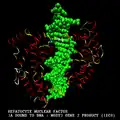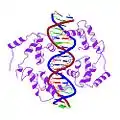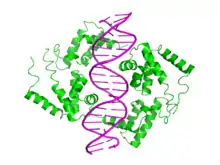Hepatocyte nuclear factors
Hepatocyte nuclear factors (HNFs) are a group of phylogenetically unrelated transcription factors that regulate the transcription of a diverse group of genes into proteins. These proteins include blood clotting factors and in addition, enzymes and transporters involved with glucose, cholesterol, and fatty acid transport and metabolism.[1][2]
Function
As the name suggests, hepatocyte nuclear factors are expressed predominantly in the liver. However HNFs are also expressed and play important roles in a number of other tissues so that the name hepatocyte nuclear factor is somewhat misleading. Nevertheless, the liver is the only tissue in which a significant number of different HNFs are expressed at the same time. In addition, there are a number of genes which contain multiple promoter and enhancer regions each regulated by a different HNF. Furthermore, efficient expression of these genes require synergistic activation by multiple HNFs. Hence hepatocyte nuclear factors function to ensure liver specific expression of certain genes.
As is the case with many transcription factors, HNFs regulate the expression of a wide variety of target genes and therefore functions. These functions (and especially functions involving the liver) include development and metabolic homeostasis of the organism. For example, HNFs influence expression of the insulin gene as well as genes involved in glucose transport and metabolism. In embryo development, HNF4α is thought to have an important role in the development of the liver, kidney, and intestines.
Disease implication
Variants of the genes can cause several relatively rare forms of MODY, an inherited, early onset form of diabetes. Mutations in the HNF4α, HNF1α, or HNF1β genes are linked to MODY 1, MODY 3, and MODY 5 respectively.[3] Mutations in HNF genes are also associated with a number of others diseases including hepatic adenomas and renal cysts.
Members
The following is a list of human hepatocyte nuclear factors (see also boxes to the right for additional information about these proteins):
HNF1
Members of the HNF1 subfamily contain a POU-homeodomain and bind to DNA as homodimers.
|
| ||||||||||||||||||||||||||||||||||||||||||||||||||||||||||||||||||
HNF3
The HNF3 subfamily members contain a winged helix DNA-binding domain and bind to DNA as monomers.
- HNF3α/FOXA1 (forkhead box A1)
- HNF3β/FOXA2 (forkhead box A2)
- HNF3γ/FOXA3 (forkhead box A3)
|
|
| ||||||||||||||||||||||||||||||||||||||||||||||||||||||||||||||||||||||||||||||||||||||||||
HNF4
Members of the HNF4 subfamily are nuclear receptors and bind to DNA either as homodimers or RXR heterodimers.
|
| ||||||||||||||||||||||||||||||||||||||||||||||||||||||||||||||||
HNF6
The HNF6 subfamily members contain a cut-homeodomain (ONECUT) bind to DNA as monomers.
|
| ||||||||||||||||||||||||||||||||||||||||||||||||||||||||||||
References
- Costa RH, Kalinichenko VV, Holterman AX, Wang X (2003). "Transcription factors in liver development, differentiation, and regeneration". Hepatology. 38 (6): 1331–47. doi:10.1016/j.hep.2003.09.034. PMID 14647040. S2CID 2646966.
- Mitchell SM, Frayling TM (2002). "The role of transcription factors in maturity-onset diabetes of the young". Mol Genet Metab. 77 (1–2): 35–43. doi:10.1016/S1096-7192(02)00150-6. PMID 12359128.
- Ryffel GU (2001). "Mutations in the human genes encoding the transcription factors of the hepatocyte nuclear factor (HNF)1 and HNF4 families: functional and pathological consequences". J Mol Endocrinol. 27 (1): 11–29. doi:10.1677/jme.0.0270011. PMID 11463573.
Additional images

 Different rendering of HNF1a bound to DNA
Different rendering of HNF1a bound to DNA
External links
- Hepatocyte+Nuclear+Factors at the U.S. National Library of Medicine Medical Subject Headings (MeSH)
- Transcription networks in the liver
- transthyretin promoter, an example of a regulatory region containing HNF binding sites
- HNF4 in genetics of diabetes
